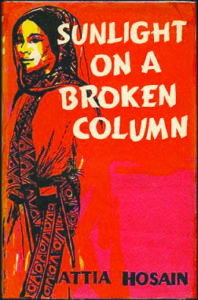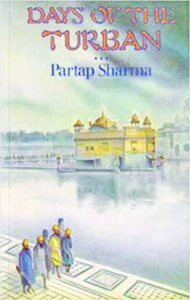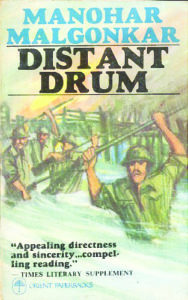By Vikas Datta
There can be endless arguments on whether a novel is literature, literary fiction, or genre  fiction, but its ability to portray the experience of a historic place and time, at the level of the individual, cannot be gainsaid by memoirs, which may not be impartial, or academic histories, which usually focus on a larger picture.
fiction, but its ability to portray the experience of a historic place and time, at the level of the individual, cannot be gainsaid by memoirs, which may not be impartial, or academic histories, which usually focus on a larger picture.
What can give a better insight into the horrors and lingering effects of war than Erich Maria Remarque’s All Quiet on the Western Front (1929), or the dehumanising – and often fatal – consequences of racial prejudice and the ‘lynch mob’ mentality than Harper Lee’s To Kill a Mockingbird (1960), or the ramifications of colonialism on indigenous cultures than Chinua Achebe’s Things Fall Apart (1958), to take a few examples.
Indian novels, in English and other languages, do not lag in any respect to their global counterparts, since the form emerged across the country in the late 19th century. While Devaki Nandan Khatri’s Chandrakanta (Hindi, 1888) was fantasy, drawing on the Persian-Urdu ‘dastangoi’ oral storytelling tradition, Bankim Chandra Chattopadhyay’s Anandamath (Bengali, 1882), and Nandshankar Mehta’s Karan Ghelo (Gujarati, 1866), among others, had historical themes, many were rooted in the contemporary world and its problems.
Some did serve as an impetus for social progress, with a story getting the message across better than a tract, most did offer a sparkling and insightful description of the society they  were set in, its mores and norms, and the state of the language, its idioms, slang, and more.
were set in, its mores and norms, and the state of the language, its idioms, slang, and more.
The depictions of Tsarist Russia and Ottoman Turkey in Fasana-e-Azad (Urdu, 1881) by Ratan Nath Dhar Sarshar may be imaginary, but the description of the manners and customs of the late 19th-century Lucknow, which account for most of the massive tome (four volumes), is spot-on.
Peary Chand Mitra did the same for the then Calcutta in Alaler Gharer Dulal (Bengali, 1857) and Samuel Vedanayagam Pillai for Madras in Prathapa Mudaliar Charithram (Tamil, written in 1857 and published in 1879).
Sharda Ram Phillauri’s Bhagyawati (Hindi, 1877) had a more prescriptive tone, frowning on child marriage and favouring widow remarriage, and Hari Narayan Apte’s Pan Lakshat Kon Gheto (Marathi, 1890) was the sobering “autobiography” of a young woman buffeted by a mostly adverse society. And in the 20th century and onwards, there is an abundance of plenty.
Indian literature, especially in English, both as an original source and in translations, can offer a novel for any mood and purpose the reader may seek, be it pure diversion or a more instructive purpose. For the latter, let’s take up five-odd works – once famous but now forgotten and some even out of print – from the recent past, which may have some bearing on our present times.
Amid the debate over heritage, colonial and otherwise, in the country and in its institutions,  especially in the Army, Manohar Malgonkar’s Distant Drum (1960) is instructive.
especially in the Army, Manohar Malgonkar’s Distant Drum (1960) is instructive.
Beginning with career army officer Kiran Garud’s life commanding his regiment (‘The Satpuras’) in a cantonment somewhere in Central India soon after Independence, it sees him move to a staff job at the Army HQ in New Delhi, where a romantic tangle – worthy of a Bollywood potboiler – sends him opting for active service in Jammu and Kashmir, where he gets into another career-disrupting incident, before redemption, on the personal and professional front. Interpersed are digressions into the beginning of his career, and his experiences of World War II, and the Partition.
On a wider perspective, it is about the British-Indian relationship in the colonial army and the Indians and Pakistanis in the armies after Independence as well as Indian civil-military relationships with some of both not coming off too well.
The underlying lesson is that there is good and bad in people as well as things, we cannot be selective about the pasts we want to adopt, and, according to scholar Usha Bande, Malgonkar’s belief that “everything British need not be condemned in our enthusiasm to celebrate ‘nationalism’.”
Attia Hossain’s Sunlight on a Broken Column (1961) is a coming-of-age story of an orphaned Muslim girl from a landed family in Lucknow growing up in the 1930s, and the series of choices she has to make in her life, both personal and political, rising in complexity and consequences, to the biggest one in 1947.
Laila, whose story in a way echoes that of the author herself, is raised at her grandfather’s house after her parents’ passing. After his death, she becomes the ward of her uncle, who is both authoritarian and liberal, allowing her to pursue modern education but seeks to retain control of her life otherwise – a feature we have come to see is scarcely dated and is much around today as it was then – and her rebellion is inevitable.
These may be seen as the account or outlook of an ‘Anglicised’ section, but let us look at the other side of the spectrum.
Shrilal Shukla’s satirical Raag Darbari (Hindi, 1967) shows that life in the ‘Bharat’ beyond the metros is neither straightforward, nor simple, and the pursuit or perpetuation of “tradition” is not always desirable. Set in the village of ‘Shivpalganj’ somewhere in Uttar Pradesh, it is a collection of vignettes without a defined protagonist, and the characters are rather eccentric and devious.
The narrator is Ranganath, who comes to the village to recuperate after completing his post-graduate education. He observes the jostling for power and position that constitutes local politics, from his uncle Vaidyaji, the manager of the local school and centrepoint of all village politics, and his younger son Ruppan, who stays on in Class 10 for 10 years to be able to carry on in student politics.
The elder son, Badri Pehelwan, eschews politics and concentrates on bodybuilding. The other characters include the principal with a penchant for rustic dialect, the drunk goon who invents a new ‘language’, the hapless common man, and more.
A more ominous tone can be found in Partap Sharma’s The Days of the Turban (1986), set in Punjab, where the spectre of terrorism is slowly spreading, and a syncretic way of life is fast disappearing.
Balbir, the youngest of a land-owning Mohyal family in a village, is chafing against his rustic life and dreams of moving to Europe like his elder brother and cousin.
This leads him to get involved with a local gun-runner, and then get trapped in the Golden Temple as Bhindrawale’s men cement control and make him a hostage to force his cousin, an arms supplier, to make deals with them.
The cousin ties up with intelligence to frustrate the terrorists’ plans and the family patriarch, Lokraj, carries out an audacious plan to rescue his grandson from right under the extremists’ eyes, and then deals with the man who got him embroiled.
Nalinaksha Bhattacharya’s A Fistful of Desire (1997) is about power, love and social responsibility – in rather unique manifestations – in a pre-social media age.
At its centre are the shenanigans of a powerful bureaucrat in the PMO who becomes rather too enamoured of a British woman, who seeks his help to locate her husband, who went missing while on a scientific survey in the Andaman and Nicobar Islands. As he makes increasingly elaborate plans to seduce her, the woman, sensing his intentions, summons her younger boyfriend from London to help. A search is ultimately mounted but with results scarcely expected.
Eventually, it ends happily – though a bit unexpectedly also – and even our bureaucrat displays a soft side, but doesn’t forget his amorous intentions.
Some of these books, unfortunately, are unavailable or out of print. Time for publishers to step in and resurrect these writers for a new generation?



